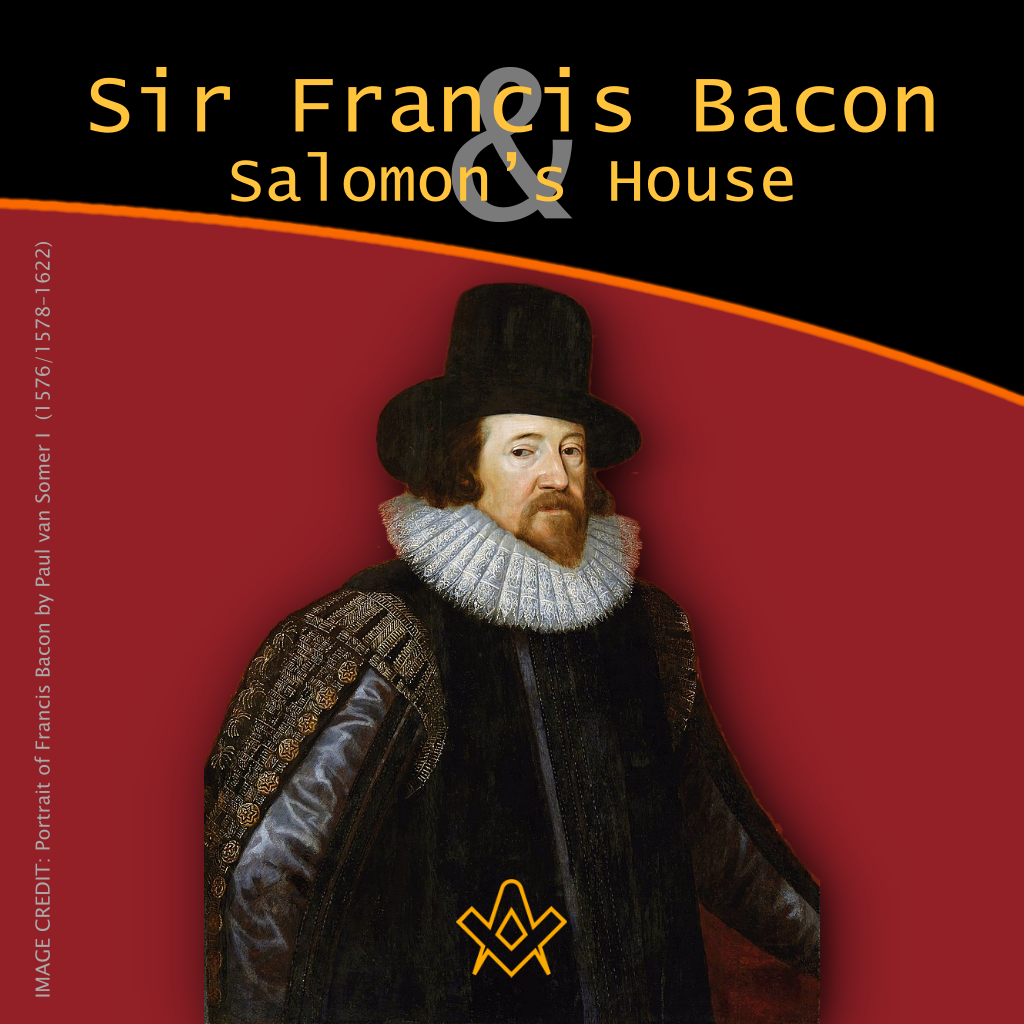There are many theories concerning the origins of Freemasonry, some more outlandish than others; some based on the most rigorous academic techniques, and others of a more speculative nature. Each has its place, and each has its followers and detractors.
The most widely accepted and prosaic theory holds that Freemasonry is derived from medieval operative stonemason lodges, which eventually opened up membership to non-operatives, thereby becoming a more speculative organisation of men; for whom the practical elements of stonemasonry became purely symbolical.
Sir Francis Bacon and Salomon’s House
Article by: Frater Kenneth C. Jack: V˚, East of Scotland College, S.R.I.S.
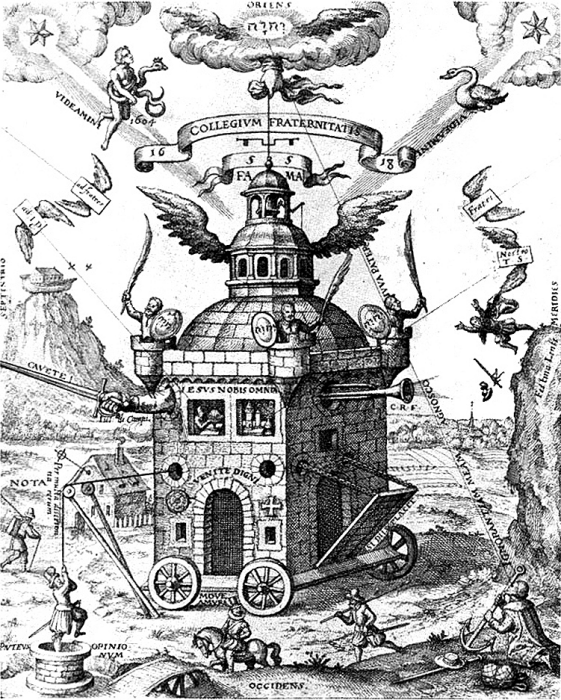
The Temple of the Rose Cross. From Speculum Sophicum Rhodostauroticum [Mirror of the Wisdom of the Rosy Cross], Teophilus Schweighardt Constantiens, 1618.
IMAGE LINKED: wikimedia Attribution 4.0 International (CC BY 4.0)
One other theory suggests that Masonry is derived from a mysterious and shadowy 17th century organisation calling itself the Rosicrucians, or “The Brethren of the Rosy Cross”.
In 1614, a manifesto referred to as the Fama Fraternitatis was published in Germany.
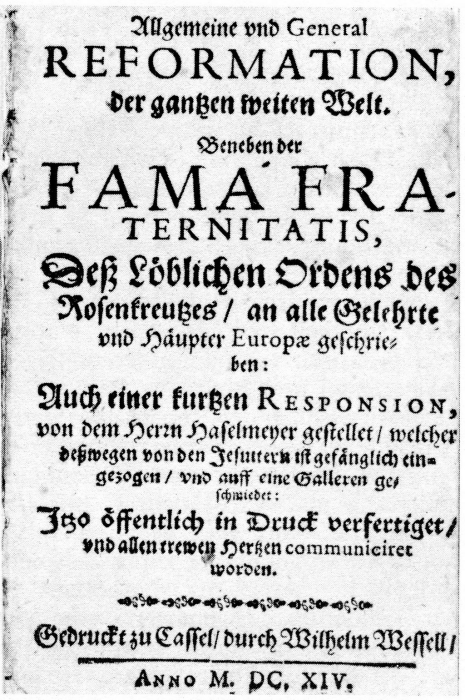
First page of the “Fama Fraternitatis”, 1614.
IMAGE LINKED: wikimedia Attribution 4.0 International (CC BY 4.0)
It is thought that similar documents had been circulating for many years previously, but this manifesto urged the learned of Europe to join with these brethren in the objective of making improvements in scientific, philosophical, and religious education.
It also appeared to call for the overthrow of the oppressive behaviour and orthodoxy of the Roman Catholic Church, which was seen as a barrier to the freedom to explore these subjects in a more open-minded and empirical fashion, free of superstition, and dogmatic scaremongering.
The author of this work is believed to have been one Johann Valentin Andreae. There is some doubt about whether Andreae meant this as a serious document, or whether in fact he intended it as a joke at the expense of persons of that persuasion.
Nevertheless, many took the document at face-value and various Rosicrucian groups sprang up throughout Germany and then into Europe and Britain. Andreae followed this up with a similar work: Confessio Fraternitatis.
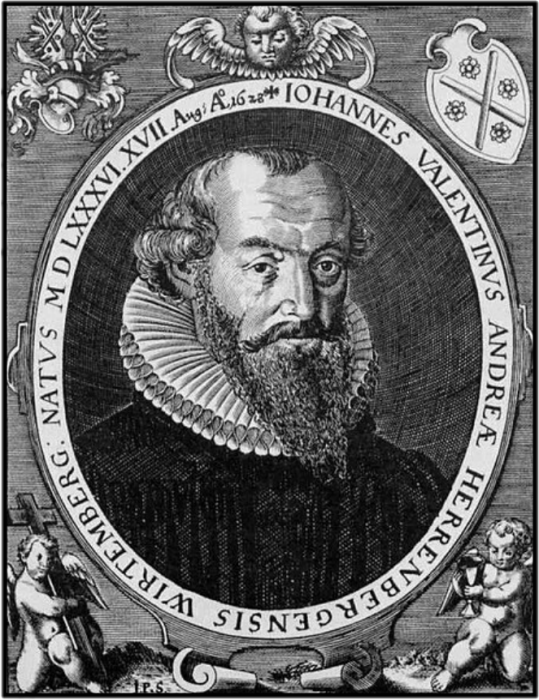
Johann Valentin Andreae (1586-1654).
IMAGE LINKED: wikimedia Attribution 4.0 International (CC BY 4.0)
Over the years, many historical figures, including Sir Robert Moray, the Scottish nobleman and Freemason have been claimed as Rosicrucians. Another notable figure accorded this epithet is Francis Bacon, later Sir Francis Bacon. Bacon was born in London in 1561 to an important English family.
He briefly flirted with a legal career, and for a period was a favourite of Queen Elizabeth I; but after criticising a proposed new tax, he fell out of favour and his career as a lawyer stalled.
However, in 1603, James I became King and from then, Bacon’s career took off; he was knighted, and rose quickly through the legal ranks, and by 1618 he was Lord Chancellor, a position which gave him great power.
However, this period of power was to be short-lived, for in 1621 he was arrested for bribery in a legal case.
He admitted his guilt and after a period of imprisonment in the Tower of London, was barred from holding political office again.
A paradoxical note in all this is that bribery in those days was common place, and Bacon actually found against those who bribed him!
However, he fully accepted that his behaviour fell short of that expected of him and readily accepted his punishment.
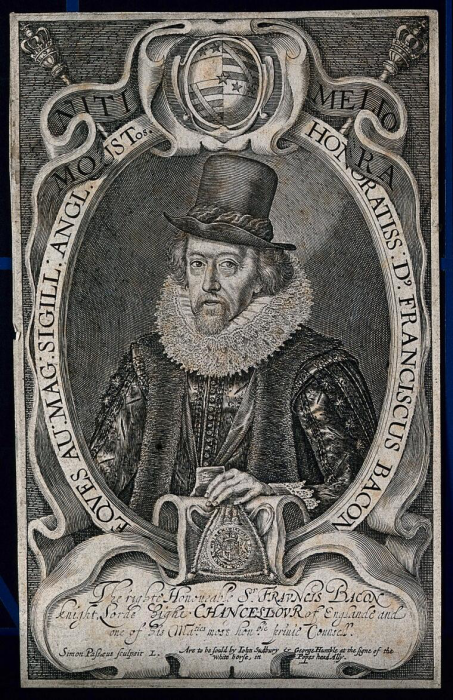
Francis Bacon, Viscount St Albans (1561-1626). Line engraving by S. van der Passe.
IMAGE LINKED: wellcome collection Attribution 4.0 International (CC BY 4.0)
His fall from grace allowed him to pursue his other interests, prime of which was his desire to see improvements in education.
Bacon promoted a more empirical approach to the study of science for example, believing that the truth of things should be judged purely on what could be observed and measured, and proved in a scientific, chronological fashion.
He railed against the approach adopted by many Aristotelians, although at the same time, he did agree with much of what the great man himself wrote.
Bacon wrote a number of works related to this, one of which was called The Advancement of Learning.
Bacon’s theories later influenced a group of men who went on to create the Royal Society of London, an organisation which boasted a number of known Freemasons amongst its founder members – such as the aforementioned Sir Robert Moray. [1]
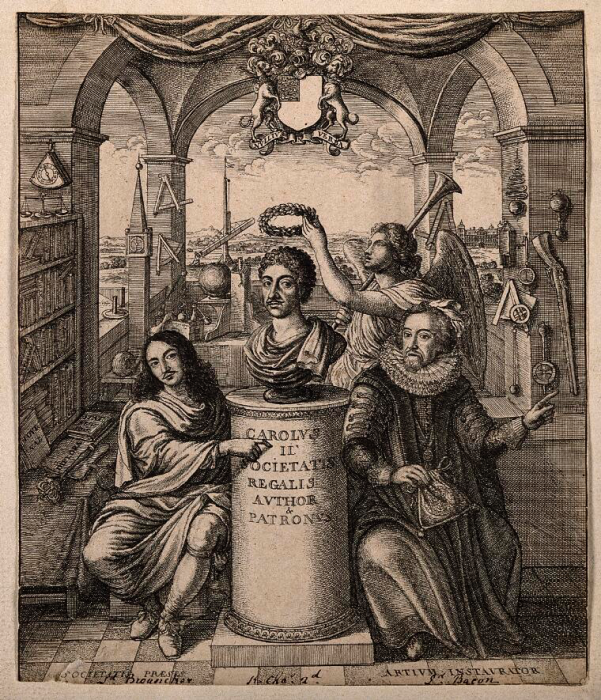
Francis Bacon and William Brouncker flanking a bust of King Charles II set on a pedestal, surrounded by symbols of scientific learning representing the Royal Society. Etching by W. Hollar, 1667, after J. Evelyn.
IMAGE LINKED: wellcome collection Attribution 4.0 International (CC BY 4.0)
Another book written by Bacon has often been cited as indicating that he was in fact a Rosicrucian, and therefore probably a Freemason too.
The book, entitled The New Atlantis, is a work of fiction concerning a brotherhood, who create an establishment variously referred to as: the House of Strangers, Salomon’s House, or the College of the Six Day’s Works.
This establishment was also dedicated to the advancement of learning, and the writing of books, aimed at improving the knowledge of all things, including the arts and sciences; which at times were also to be dedicated to the State.
Notwithstanding his devotion to academic rigour in the scientific investigation of all things, Bacon is widely believed to have been interested in hermetic philosophy, and the Christian Cabala [Kabbalah] – the Cabala being a system said to have been handed down from the ancient Egyptian sage, Hermes Trismegistus.
It was also a philosophy which interested many of his contemporaries such as Elias Ashmole, Thomas Vaughan, and the Rosicrucian apologist Robert Fludd.
This might on one level seem incongruous; but it should be noted that Sir Isaac Newton is known to have had a deep interest in the subject of alchemy, despite being one of the most academically rigorous scientists of all time.
Many commentators believe that Freemasonry is descended from the Rosicrucians, or is at least influenced by Rosicrucian philosophy; they point to the structures, symbolism, and hermetic influences in both societies as evidence.
The well-known, though controversial Masonic writer Manly P. Hall stated:
One theory concerning the two Orders is to the effect that Freemasonry was an outgrowth of Rosicrucianism; in other words that the “Unknown Philosophers” became known through an organisation which they created to serve them in the material world.
The story goes on to relate that the Rosicrucian adepts became dissatisfied with their progeny and silently withdrew from the Masonic hierarchy, leaving behind their symbolism and allegories, but carrying away the keys by which the locked symbols could be made to give tip to their secret meanings.
Speculators have gone so far as to state that, in their opinion, modern Freemasonry has completely absorbed Rosicrucianism and succeeded it as the world’s greatest secret society. [2]
It is interesting to note that Hall refers to the promoters of these theories as “Speculators”, and of course that is all it is, and can be.
It is always interesting to speculate; gamblers will tell you that you “have to speculate to accumulate”; speculative books can provide many hours of entertainment, and of course gold speculators occasionally strike rich seams of that precious metal, making them instantly rich.
But as Francis Bacon advocated; serious students of history must go where the verifiable facts take them. Whether Francis Bacon was a so-called Rosicrucian or Freemason may never be known, and the question will probably remain forever within the domain of the “Speculators”.
Speculation runs rife, as many also believe that Francis Bacon was the true author of the works attributed to William Shakespeare – and moreover; many see Masonic symbolism in the Bard’s works.
Let us take a look at some the words of both Sir Francis Bacon and the Rosicrucian Brotherhood, and the discerning reader can make up his own mind about whether he falls into the camp of “Speculator” or “Empiricist”. Manly P. Hall also wrote:
Some are of the opinion that Sir Francis Bacon had a hand in the writing of the Fama and Confessio Fraternitatis, on the basis that the rhetorical style of these works is similar to that of Bacon’s New Atlantis.
They also contend that certain statements in the latter work point to an acquaintance with Rosicrucian symbology. [3]
The following are extracts from Bacon’s “The New Atlantis”:-
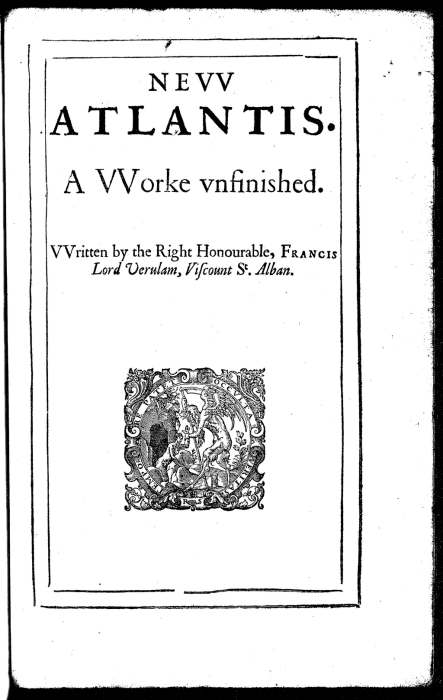
Title page of “New Atlantis” in the second edition of Francis Bacon’s “Sylva sylvarum: or A naturall historie. In ten centuries.” London. Printed by J.H. for William Lee at the Turkes Head in Fleet-street, next to the Miter, 1628.
IMAGE LINKED: wikimedia Attribution 4.0 International (CC BY 4.0)
THE NEW ATLANTIS
The morrow after our three days were past, there came to us a new man that we had not seen before, clothed in blue as the former was, save that his turban was white with a small red cross on the top. He had also a tippet of fine linen.
At his coming in, he did bend to us a little, and put his arms abroad. We of our parts saluted him in a very lowly and submissive manner; as looking that from him we should receive sentence of life or death.
He desired to speak with some few of us. Whereupon six of us only stayed, and the rest avoided the room.
He said;
“I am by office Governor of this House of Strangers, and by vocation I am a Christian priest; and therefore am come to you to offer you my service, both as strangers, and chiefly as Christians.
Some things I may tell you, which I think you will not be unwilling to hear. The State hath given you licence to stay on land for the space of six weeks; and let it not trouble you, if your occasions ask further time as shall be convenient.”
About twenty years after the Ascension of our Saviour it came to pass, that there was seen by the people of Renfusa (a city upon the eastern coast of our island) within sight (the night was cloudy and calm), as it might be some mile in the sea, a great pillar of light; not sharp, but in form of a column, or cylinder, rising from the sea, a great way up towards Heaven; and on the top of it was seen a large cross of light, more bright and resplendent than the body of the pillar.
Upon which so strange a spectacle the people of the city gathered apace together upon the sands, to wonder; and so after put themselves into a number of small boats to go nearer to this marvellous sight.
But when the boats were come within about sixty yards of the pillar they found themselves all bound, and could go no further, and yet so as they might move to go about, but might not approach nearer; so as the boats stood all as in a theatre, beholding this light, as an heavenly sign.
It so fell out, that there was in one of the boats one of our wise men, of the Society of Salomon’s House; which house or college, my good brethren, is the very eye of this kingdom, who having a while attentively and devoutly viewed and contemplated this pillar and cross, fell down upon his face; and then raised himself upon his knees, and lifting up his hands to Heaven, made his prayers in this manner:
Lord God of Heaven and earth; Thou hast vouchsafed of Thy grace, to those of our order, to know Thy works of creation, and the secrets of them; and to discern (as far appertaineth to the generations of men) between divine miracles, works of Nature, works of art, and impostures and illusions of all sorts.
I do here acknowledge and testify before this people, that the thing which we now see before our eyes is Thy finger, and a true miracle.
And forasmuch as we learn in our books that Thou never workest miracles, but to a divine and excellent end (for the laws of nature are Thine own laws, and thou exceedest them not but upon great cause), we must humbly beseech thee to prosper this great sign, and to give is the interpretation and use of it in mercy; which Thou dost in some part secretly promise, by sending it unto us.
When he had made his prayer, he presently found the boat, he was in movable and unbound; whereas all the rest remained still fast; and taking that for an assurance of leave to approach, he caused the boat to be softly and with silence rowed towards the pillar.
But ere he came near it, the pillar and cross of light broke up, and cast itself abroad, as it were, into a firmament of many stars, which also vanished soon after, and there was nothing left to be seen but a small ark, or chest of cedar, dry, and not wet at all with water, though it swam.
And in the fore-end of it, which was towards him, grew a small green branch of palm; and when the wise man had taken it with all reverence into his boat, it opened of itself, and there was found in it a book and a letter, both written in fine parchment, and wrapped in sindons of linen.
The book contained all the canonical books of the Old and New Testament, according as you have them (for we know well what the Churches with you receive) and the Apocalypse itself; and some other books of the New Testament, which were not at that time written, were nevertheless in the book. And for the letter, it was in these words:
I Bartholomew, a servant of the highest, and apostle of Jesus Christ, was warned by an angel that appeared to me in a vision of glory, that I should commit this ark to the floods of the sea.
Therefore I do testify and declare unto that people where God shall ordain the ark to come to land, that in the same day is come unto them salvation and peace and goodwill from the Father, and from the Lord Jesus.
There was also in both these writings, as well the book as the letter, wrought a great miracle, conform to that of the apostles, in the original gifts of tongues.
For there being at that time, in this land, Hebrews, Persians, and Indians, besides the natives, every one read upon the book and letter, as if they had been written in his own language.
And thus was this land saved from infidelity (as the remain of the Old World was from water) by an ark, through the apostolical and miraculous evangelism of St. Bartholomew.
And here he paused, and a messenger came, and called him forth from us. So that was all that passed in that conference.
Ye shall understand my dear friends, that amongst the excellent acts of that king, one above all hath the pre-eminence.
It was the erection and institution of an order, or society, which we call Salomon’s House; the noblest foundation, as we think, that ever was upon the earth, and the lantern of this kingdom.
It is dedicated to the study of the works and creatures of God. Some think it beareth the founder’s name a little corrupted, as if it should be Solomona’s House.
But the records write it as it is spoken. So as I take it to be denominate of the king of the Hebrews, which is famous with you, and no stranger to us; for we have some parts of his works with which you are lost; namely that Natural History which he wrote of all plants, from the cedar of Libanus to the moss that growth out of the wall; and of all things that have life and motion.
This maketh me think that our king finding himself to symbolise, in many things, with that king of the Hebrews (which lived many years before him) honoured him with the title of this foundation.
And I am the rather induced to be of this opinion, for that I find in ancient records, this order or society is sometimes called Salomon’s House, and sometimes the College of the Six Day’s Works; whereby I am satisfied that our excellent king had learned from the Hebrews that God had created the world, and all that therein is, within six days; and therefore he instituting that house, for the finding out of the true nature of all things (whereby God mought have the more glory in the workmanship of them, and men the more fruit in the use of them), did give it also that second name.
These caves we call the lower region, and we use them for all coagulations, indurations, refrigerations, and conservations of bodies.
We use them likewise for the imitation of natural mines, and the producing also of new artificial metals, by compositions and materials which we use, and lay there for many years.
We use them also sometimes (which may seem strange) for curing of some diseases, and for prolongation of life in some hermits that choose to live there, well accommodated of all things necessary, and indeed live very long; by whom also we learn many things.
We have burials in several earths, where we put divers cements, as the Chinese do their porcelain.
But we have them in greater variety, and some of them more fine. We also have great variety of composts and soils, for the making of the earth fruitful.
We have high towers, the highest about half a mile in height, and some of them likewise set upon high mountains, so that the vantage of the hill, with the tower, is in the highest of them three miles at least.
And these places we call the upper region, accounting the air between the high places and the low as a middle region.
We use these towers according to their several heights and situations, for insulation, refrigeration, conservation, and for the view of divers meteors – as winds, rain, snow, hail; and some of the fiery meteors also.
Sand upon them, in some places, are dwellings of hermits, whom we visit sometimes, and instruct what to observe.
We have great lakes, both salt and fresh, whereof we have use for the fish and fowl.
We use them also for burials of some natural bodies, for we find a difference in things buried in earth, or in air below the earth, and things buried in water.
We have also pools, of which some do strain fresh water out of salt, and others by art do turn fresh water into salt.
We have also some rocks in the midst of the sea, and some bays upon the shore for some works, wherein is required the air and vapour of the sea.
We have likewise violent streams and cataracts, which serve us for many motions; and likewise engines for multiplying and enforcing of winds to set also in divers motions.
We have also a number of artificial wells and fountains, made in imitation of the natural sources and baths, as tincted upon vitriol, sulphur, steel, brass, lead, nitre, and other minerals; and again we have little wells for infusions of many things, where the waters take the virtue quicker and better than in vessels or basins.
And amongst them we have a water, which we call Water of Paradise, being by that we do to it made very sovereign for health and prolongation of life.
We have also great and spacious houses, where we imitate and demonstrate meteors – as snow, hail, rain, some artificial rains of bodies, and not of water, thunders, lightnings; also generations of bodies in air – as frogs, flies, and divers others.
We also have certain chambers, which we call chambers of health, where we qualify the air as we think good and proper for the cure of divers diseases, and preservation of health.
We have also fair and large baths, of several mixtures, for the cure of diseases and the restoring of man’s body from arefaction; and others for the confirming of it in strength of sinews, vital parts, and the very juice and substance of the body.
These are, my son, the riches of Salomon’s House. For the several employments and offices of our fellows we have twelve that sail into foreign countries under the names of other nations (for our own we conceal) who bring us the books and abstracts, and patterns of experiments of all other parts. These we call Merchants of Light.
We have three that collect the experiments which are in all books. These we call Depredators.
We have three that collect the experiments of all mechanical arts, and also of liberal science, and also of practises which are not brought into arts. These we call mystery-men.
We have three that try new experiments, such as themselves think good. These we call Pioneers or Miners.
We have three that draw the experiments of the former four into titles and tables, to give the better light for the drawing of observations and axioms out of them. These we call Compilers.
We have three that bend themselves, looking into the experiments of their fellows, and cast about how to draw out of them things of use and practice for man’s life and knowledge, as well for works as for plain demonstration of causes, means of natural divinations, and the easy and clear discovery of the virtues and parts of bodies. These we call dowry-men or Benefactors.
Then after divers meetings and consults of our whole number, to consider of the former labours and collections, we have three that take care out of them to direct new experiments, of a higher light, more penetrating into Nature than the former. These we call Lamps.
We have three others that do execute the experiments so directed, and report them. These we call Inoculators.
Lastly, we have three that raise the former discoveries by experiments into greater observations, axioms, and aphorisms. These we call Interpreters of Nature.
We have also as you must think, novice, and apprentices, that the succession of the former employed men do not fail; besides a great number of servants and attendants, men and women.
And this we do also; we have consultations, which of the inventions and experiences which we have discovered shall be published, and which not; and take all an oath of secrecy for the concealing of those which we think for to keep secret: though some of those we do reveal sometimes to the State, and some not.
For our ordinances and rites, we have two very long and fair galleries: in one of these we place patterns and samples of all manner of the more rare and excellent inventions: in the other we place the statues of all principle inventors.
There we have the stature of your Columbus that discovered the West Indies: also the inventor of ships: your Monk that was the inventor of ordinance and of gunpowder: the inventor of music: the inventor of letters: the inventor of printing: the inventor of observations of astronomy: the inventor of works in metal: the inventor of glass: the inventor of silk of the worm: the inventor of wine: the inventor of corn and bread: the inventor of sugars: and all these by more certain tradition than you have.
Then we have divers inventors of our own, of excellent works, which since you have not seen, it were too long to make descriptions of them: and besides, in the right understanding of those descriptions, you might easily err.
For upon every invention of value we erect a statue to the inventor, and give him a liberal and honourable reward.
These statues are some of brass, some of marble and touchstone, some of cedar and other special woods gilt and adorned: some of iron, some of silver, some of gold.
We have certain hymns and services, which we say daily, of laud and thanks to God for His marvellous works.
And forms of prayer, imploring His aid and blessing for the illumination of our labours, and the turning of them into good and holy uses.
Lastly we have circuits or visits, of divers principal cities of the kingdom: where, as it cometh to pass, we do publish such new profitable inventions as we think good.
And we do also declare natural divinations of diseases, plagues, swarms of hurtful creatures, scarcity, tempests, earthquakes, great inundations, comets, temperature of the year, and divers other things: and we give counsel thereupon, what the people shall do for the prevention and remedy of them.
And when he had said this he stood up: and I, as I had been taught, knelt down; and he laid his right hand upon my head, and said, “God bless thee, my son, and God bless this relation which I have made. I give thee leave to publish it, for the good of other nations; for we here are in God’s bosom, a land unknown”.
And so he left me: having assigned a value of about two thousand ducats for a bounty to me and my fellows.
For they give great largesse, where they come, upon all occasions.
The rest were not perfected. [4]
Compare this now with what we know of Freemasonry, and the following selected chapters from the Confessio Fraternitatis as ‘epitomised’ by Manly P. Hall [“The Secret Teachings of All Ages”]:
CONFESSIO FRATERNITATIS R.C. AD ERUDITOS EUROPAE [The Confession of the Laudable Fraternity of the Most Honorable Order of the Rosy Cross, Written to All the Learned of Europe]
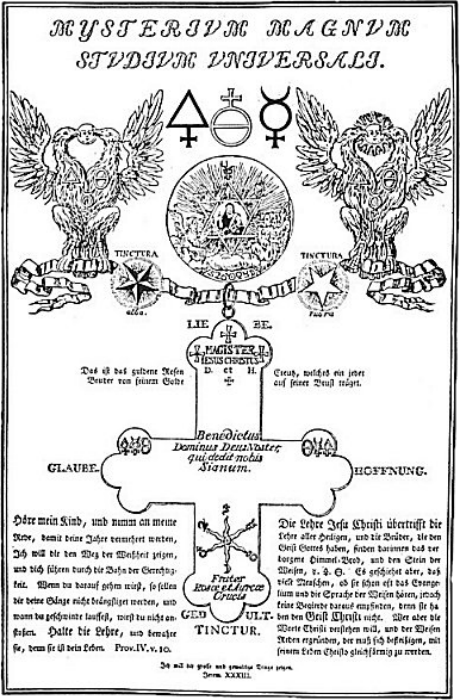
Chapter IV
We firmly believe that through deep meditation on the inventions of the human mind and the mysteries of life, through the cooperation of the angels and spirits, and through experience and long observation, our loving Christian Father C.R.C. was so fully illumined with God’s wisdom that were all the books and writings of the world lost and the foundations of science overturned, the Fraternity of R.C. could re-establish the structure of the world thought upon the foundation of divine truth and integrity.
Because of the great depth and perception of our knowledge, those desiring to understand the mysteries of the Fraternity of R.C. cannot attain to that wisdom immediately, but must grow in understanding and knowledge.
Therefore, our fraternity is divided into grades through which each must ascend step by step to the Great Arcanum.
Now that it has pleased God to lighten unto us His sixth candelabrum, is it not better to seek truth in this way than to wander through the labyrinths of worldly ignorance.
Furthermore, those who receive this knowledge shall become masters of all arts and crafts; no secret shall be hidden from them; and all good works of the past, present, and future shall be accessible to them.
The whole world will become as one book and the contradictions of science and theology shall be reconciled.
Rejoice, O humanity! for the time has come when God has decreed that the number of the fraternity shall be increased, a labour that we have joyously undertaken.
The doors of wisdom are now open to the world, but only to those who have earned the privilege may the Brothers present themselves, for it is forbidden to reveal our knowledge even to our own children.
The right to receive spiritual truth cannot be inherited: it must be evolved within the soul of man himself.
Chapter V
Though we may be accused of indiscretion in offering our treasures so freely and promiscuously-without discriminating between the godly, the wise, the prince, the peasant-we affirm that we have not betrayed our trust; for although we have published our Fama in five languages, only those understand it who have that right.
Our Society is not to be discovered by curiosity seekers, but only by serious and consecrated thinkers; nevertheless we have circulated our Fama in five mother tongues so that the righteous of all nations may have an opportunity to know us, even though they be not scholars.
A thousand times the unworthy may present themselves and clamour at the gates, but God has forbidden us of the Fraternity of R.C. to hear their voices, and He has surrounded us with His clouds and His protection so that no harm may come to us, and God has decreed that we of the Order of R.C. can no longer be seen by mortal eyes unless they have received strength borrowed from the eagle.
We further affirm that we shall reform the governments of Europe and pattern them according to the system applied by the philosophers of Damcar.
All men desirous of securing knowledge shall receive as much as they are capable of understanding.
The rule of false theology shall be overthrown and God shall make His will known through his chosen philosophers.
Chapter VII
Because of the need of brevity, it is enough to say that our Father C.R.C. was born in the year 1378 and departed at the age of 106, leaving to us the labour of spreading the doctrine of philosophic religion to the entire world.
Our fraternity is open to all who sincerely seek for truth; but we publicly warn the false and impious that they cannot betray or injure us, for God has protected our Fraternity, and all who seek to do it harm shall have their evil designs return and destroy them, while the treasures of our Fraternity shall remain untouched, to be used by the Lion in the establishment of his kingdom.
Chapter XI
We wish the statements we made in the Fama Fraternitatis concerning the transmutation of metals and the universal medicine to be lightly understood.
While we realise that both these works are attainable by man, we fear that many really great minds may be led away from the true quest of knowledge and understanding if they permit themselves to limit their investigation to the transmutation of metals.
When to a man is given power to heal disease, to overcome poverty, and to reach a position of worldly dignity, that man is beset by numerous temptations and unless he possess true knowledge and full understanding he will become a terrible menace to mankind.
The alchemist who attains to the art of transmuting base metals can do all manner of evil unless his understanding be as great as his self-created wealth.
We therefore affirm that man must first gain knowledge, virtue, and understanding; then all other things may be added unto him.
We accuse the Christian Church of the great sin of possessing power and using it unwisely; therefore we prophesy that it shall fall by the weight of its own iniquities and its crown shall be brought to naught.
Chapter XII
In concluding our Confessio, we earnestly admonish you to cast aside the worthless books of pseudo-alchemists and philosophers (of whom there are many in our age), who make light of the Holy Trinity and deceive the credulous with meaningless enigmas.
One of the greatest of these is a stage player, a man with sufficient ingenuity for imposition.
Such men are mingled, by the Enemy of human welfare among those who seek to do good, thus making Truth more difficult of discovery.
Believe us, Truth is simple and unconcealed, while falsehood is complex, deeply hidden, proud, and its worldly knowledge, seemingly a glitter with godly luster, is often mistaken for divine wisdom.
You that are wise will turn from these false teachings and come to us, who seek not your money but freely offer you our greater treasure.
We desire not your goods, but that you should become partakers of our goods.
We do not deride parables, but invite you to understand all parables and all secrets.
We do not ask you to receive us, but invite you to come into our kingly houses and palaces, not because of ourselves but because we are so ordered by the Spirit of God, the desire of our most excellent Father C.R.C., and the need of the present moment, which is very great.
Chapter XIII
Now that we have made our position clear that we sincerely confess Christ; disavow the Papacy; devote our lives to true philosophy and worthy living; and daily invite and admit into our Fraternity the worthy of all nations, who thereafter share with us the Light of God: will you not join yourselves with us to the perfection of yourselves, the development of all the arts, and the service of the world?
If you will take this step, the treasures of every part of the earth shall at one time be given unto you, and the darkness which envelopes human knowledge and which results in the vanities of material arts and sciences shall be forever dispelled.
Chapter XIV
Again we warn those who are dazzled by the glitter of gold or those who, now upright, might be turned by great riches to a life of idleness and pomp, not to disturb our sacred silence with their clamorings; for though there be a medicine which will cure all diseases and give unto all men wisdom, yet it is against the will of God that men should attain to understanding by any means other than virtue, labour, and integrity.
We are not permitted to manifest ourselves to any man except it be by the will of God.
Those who believe that they can partake of our spiritual wealth against the will of God or without His sanction will find that they shall sooner lose their lives in seeking us than attain happiness by finding us.
FRATERNITATIS R.C . [5]
Footnotes
Reference
NOTES
[1] The Francis Bacon Research Trust, http://www.fbrt.org.uk/pages/fbrt/frameset-fbrt.html, accessed May 1st, 2014.
[2] Manly P. Hall: ‘The Fraternity of the Rose Cross’ (1928), as reproduced in ‘Freemasons & Rosicrucians, The Enlightened’ Collected Masonic and Rosicrucian Essays, pp 116-117, Ed. Michael R. Poll, Cornerstone Book Publishers, Charlottesville VA, and New Orleans LA. (2005).
[3] Ibid, p119.
[4] Francis Bacon: ‘Bacon’s Advancement of Learning and The New Atlantis’, Henry Frowde, Oxford University Press, London, New York, and Toronto. (1906).
[5] Hall (2005), ‘Rosicrucian Doctrines and Tenets, (1928).
Article by: Kenneth C. Jack
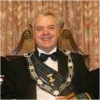
Kenneth C. Jack FPS is an enthusiastic Masonic researcher/writer from Highland Perthshire in Scotland.
He is Past Master of a Craft Lodge, Past First Principal of a Royal Arch Chapter, Past Most-Wise Sovereign of a Sovereign Chapter of Princes Rose Croix.
He has been extensively published in various Masonic periodicals throughout the world including: The Ashlar, The Square, The Scottish Rite Journal, Masonic Magazine, Philalethes Journal, and the annual transactions of various Masonic bodies.
Kenneth is a Fellow of the Philalethes Society, a highly prestigious Masonic research body based in the USA.

Francis Bacon: The Complete Works
By: Francis Bacon
This book contains the complete Francis Bacon’s works in the chronological order of their original publication.
[1597] The Essays,
[1603] Valerius Terminus: of the interpretation of Nature
[1605] The Advancement of Learning
[1620] The Great Instauration
[1620] Preparative Toward a Natural and Experimental History
[1620] The New Organon
[1627] The New Atlantis

New Atlantis and The Great Instauration
By: Francis Bacon
This richly annotated second edition of the now-classic pairing of Bacon’s masterpieces, New Atlantis and The Great Instauration features the addition of other works by Bacon, including “The Idols of the Mind,” Of Unity in Religion” and “Of the True Greatness of Kingdoms and Estates,” as well a Summary of the each work and Questions for the reader.
• Includes works new to the second edition, including “The Idols of the Mind,” “Of Unity in Religion,” and “Of the True Greatness of Kingdoms and Estates”
• Updates the layout of the previous edition with a more generous interior design, making this work more student-friendly and easier to navigate in the classroom
• Each work is introduced and subsequently discussed, revealing the importance of Bacon’s work to his contemporaries as well as to modern readers
• Includes a comprehensive introduction and annotations throughout the text; as well as an appendix of Principal Dates in the Life of Sir Francis Bacon; a selected bibliography; and synopses and questions to accompany each work

Chymical Wedding of Christian Rosenkreutz
By: Johann Valentin Andreae
The Chymical Wedding is an allegoric story divided into Seven Days, or Seven Journeys, and which tells us how Christian Rosenkreuz was invited to go to a wonderful castle full of miracles, in order to assist the Chymical Wedding of the king and the queen. The story is symbolic of alchemy, the Sacred Marriage being the goal.

The Rosicrucian Fama Fraternitatis and Confessio Fraternitatis: Esoteric Classics
By: Christian Rosenkreuz
Dating to 1614 and 1615, these are two of the three primary documents which originally announced and helped define who the secret society of Rosicrucians were. These works, written in veiled and alchemical language, outline the true philosophy of RC along with a code of conduct that members are expected to live by. These two pieces have been the subject of serious occult study for centuries since their first appearance.

The Fama Fraternitatis Of The Meritorious Order Of The Rosy Cross
By: A.E. Waite
This scarce antiquarian book is a facsimile reprint of the original. Due to its age, it may contain imperfections such as marks, notations, marginalia and flawed pages. Because we believe this work is culturally important, we have made it available as part of our commitment for protecting, preserving, and promoting the world’s literature in affordable, high quality, modern editions that are true to the original work.

The Secret Teachings of All Ages
By: Manly P. Hall
Discover the key to the world’s esoteric traditions, and unlock some of the most fascinating and closely held secrets of myth, religion, and philosophy. Unrivaled in its beauty and completeness, this classic reference distills ancient and modern teachings of nearly 600 experts.
Compelling themes range from the riddle of the Sphinx and the tenets of Pythagorean astronomy to the symbolism of the pentagram, the significance of the Ark of the Covenant, and the design of the American flag. World-renowned expert Manly P. Hall examines the secrets of Isis along with arcane aspects of supernatural phenomena, mystic Christianity, and other religions.
• The Secret Teachings of All Ages is a fascinating survey covering topics as diverse as Astrology and the Zodiac, American Indian symbolism, Egyptian ceremonial magic and sorcery, Kabbalah, alchemy, cryptology, and Tarot, along with Masonry, gemology, and the identity of William Shakespeare.
• Hundreds of entries range from classical antiquity and oracles, to Islamic and Christian history, the arcane rituals of Druids, Freemasons, Rosicrucian doctrines and tenets, alchemists, other secret societies.
• 6″ x 9″, 736 pages include 16 pages of color plates, 100 black-and-white illustrations, an extensive bibliography, and a complete index.
Shop Dover for classic, historical, and general interest books that reveal the hidden mysteries behind secret societies, the supernatural, esoteric philosophies, and other fascinating subjects such as black magic, vampirism, and witchcraft.
Recent Articles: Kenneth C. Jack
 Observations on the History of Masonic Research Archaeology is often associated with uncovering ancient tombs and fossilized remains, but it goes beyond that. In a Masonic context, archaeology can be used to study and analyze the material culture of Freemasonry, providing insight into its history and development. This article will explore the emergence and evolution of Masonic research, shedding light on the challenges faced by this ancient society in the modern world. |
 Anthony O'Neal Haye – Freemason, Poet, Author and Magus Discover the untold story of Anthony O’Neal Haye, a revered Scottish Freemason and Poet Laureate of Lodge Canongate Kilwinning No. 2 in Edinburgh. Beyond his Masonic achievements, Haye was a prolific author, delving deep into the history of the Knights Templar and leaving an indelible mark on Scottish Freemasonry. Dive into the life of a man who, despite his humble beginnings, rose to prominence in both Masonic and literary circles, leaving a legacy that continues to inspire. |
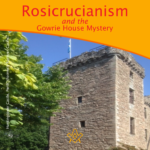 Rosicrucianism and the Gowrie House Mystery Unearth the mystifying intersections of Rosicrucianism and the infamous Gowrie House Mystery. Dive into speculative claims of sacred knowledge, royal theft, and a Masonic conspiracy, harking back to a fateful day in 1600. As we delve into this enthralling enigma, we challenge everything you thought you knew about this historical thriller. A paper by Kenneth Jack |
 Thomas Telford's Masonic Bridge of Dunkeld Of course, there is no such thing as a ‘Masonic Bridge’; but if any bridge is deserving of such an epithet, then the Bridge of Dunkeld is surely it. Designed by Scotsman Thomas Telford, one of the most famous Freemasons in history. |
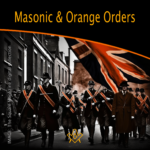 The masonic and orange orders: fraternal twins or public misperception? “Who’s the Mason in the black?” |
 Kenneth Jack's research reveals James Murray, 2nd Duke of Atholl – the 'lost Grand Master' |
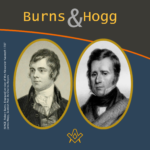 An Oration delivered to the Annual Burns and Hogg Festival, at Lodge Canongate Kilwinning, No. 2, Edinburgh, on 24 January 2018. By Bro. Kenneth C. Jack, FSAScot FPS, Past Master, Lodge St. Andrew, No. 814, Pitlochry. |
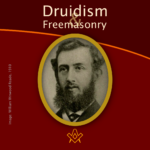 William Winwood Reade was a Scottish philosopher, historian, anthropologist, and explorer born in Crieff, Perthshire, Scotland. The following article by Kenneth Jack, provides some hints that William may have been a Freemason, but there is presently no definitive evidence he was. |
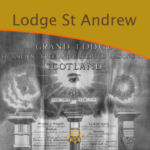 What's in a name? A brief history of the first Scottish Lodge in Australia - By Brother Kenneth C. Jack, Past Master, Lodge St. Andrew, No. 814, Pitlochry |
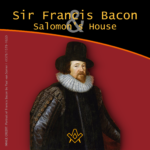 Sir Francis Bacon and Salomon’s House Does Sir Francis Bacon's book "The New Atlantis" indicate that he was a Rosicrucian, and most likely a Freemason too? Article by Kenneth Jack |
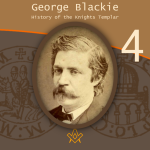 George Blackie – The History of the Knights Templar P.4 The final part in the serialisation of George Blackie's 'History of the Knights Templar and the Sublime Teachings of the Order' transcribed by Kenneth Jack. |
 George Blackie – The History of the Knights Templar P.3 Third part in the serialisation of George Blackie's 'History of the Knights Templar and the Sublime Teachings of the Order' transcribed by Kenneth Jack. |
 George Blackie – The History of the Knights Templar P.2 Second part in the serialisation of George Blackie's 'History of the Knights Templar and the Sublime Teachings of the Order' transcribed by Kenneth Jack. |
 George Blackie – The History of the Knights Templar P.1 First part in the serialisation of George Blackie's History of the Knights Templar and the Sublime Teachings of the Order – by Kenneth Jack |
 Little known as a Freemason, Bro Dr Robert ‘The Bulldog’ Irvine remains a Scottish rugby legend, and his feat of appearing in 10 consecutive international matches against England has only been surpassed once in 140 years by Sandy Carmichael. |
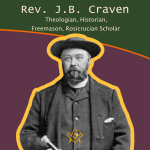 Rev. J.B. Craven: Theologian, Historian, Freemason, And Rosicrucian Scholar Archdeacon James Brown Craven is one of those unsung heroes of Scottish Freemasonry about whom very little has been previously written – here Kenneth Jack explores the life and works of this remarkable esoteric Christian. |
 Discover the powerful family of William Schaw, known as the 'Father of Freemasonry' |
 This month, Kenneth Jack invites us to look at the life of Sir William Peck; - astronomer, Freemason and inventor of the world's first electric car. A truly fascinating life story. |
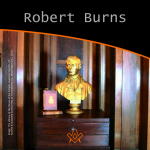 A Tribute to Scotland's Bard – The William Robertson Smith Collection With Burns' Night approaching, we pay tribute to Scotland's most famous Bard – The William Robertson Smith Collection |
 The Joy of Masonic Book Collecting Book purchasing and collecting is a great joy in its own right, but when a little extra something reveals itself on purchase; particularly with regards to older, rarer titles.. |
 Masons, Magus', and Monks of St Giles - who were the Birrell family of Scottish Freemasonry? |
 The 6th Duke of Atholl - Chieftain, Grand Master, and a Memorial to Remember In 1865, why did over 500 Scottish Freemasons climb a hill in Perthshire carrying working tools, corn, oil and wine? Author Kenneth Jack retraces their steps, and reveals all. |
 Charles Mackay: Freemason, Journalist, Writer Kenneth Jack looks at life of Bro Charles Mackay: Freemason, Journalist, Writer, Poet; and Author of ‘Tubal Cain’. |
 A Mother Lodge and a Connection Uncovered, a claim that Sir Robert Moray was the first speculative Freemason to be initiated on English soil. |
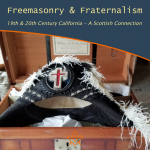 What is it that connects a very old, well-known Crieff family, with a former President of the United States of America? |
 The life of Bro. Cattanach, a theosophist occultist and Scottish Freemason |
 The Mysterious Walled Garden of Edzell Castle Explore the mysterious walled garden steeped in Freemasonry, Rosicrucianism, and Hermeticism. |
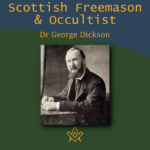 Dr. George Dickson: Scottish Freemason and Occultist Bro. Kenneth explores the life of Dr George Dickson a Scottish Freemason and Occultist |
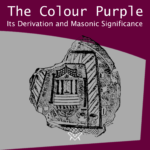 The Colour Purple - Its Derivation and Masonic Significance What is the colour purple with regards to Freemasonry? The colour is certainly significant within the Royal Arch series of degrees being emblematical of Union. |
 Bridging the Mainstream and the Fringe Edward MacBean bridging mainstream Freemasonry with the fringe esoteric branches of Freemasonry |
 Freemasonry in the Works of John Steinbeck We examine Freemasonry in the Works of John Steinbeck |
 Renegade Scottish Freemason - John Crombie Who was John Crombie and why was he a 'renegade'? |
 Scottish Witchcraft And The Third Degree How is Witchcraft connected to the Scottish Third Degree |
masonic knowledge
to be a better citizen of the world
share the square with two brothers

click image to open email app on mobile device



